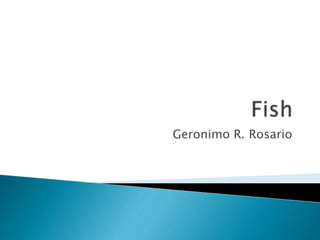Report
Share

Recommended
More Related Content
What's hot
What's hot (20)
Alimentary canal and feeding adaptations in fishes by nusrit

Alimentary canal and feeding adaptations in fishes by nusrit
fishes, Classification of fishes, types of fishes, Study of fishes

fishes, Classification of fishes, types of fishes, Study of fishes
Similar to Fish
Similar to Fish (20)
1) You need to attended two shows, they shows are only 15 minutes .docx

1) You need to attended two shows, they shows are only 15 minutes .docx
More from Geronimo Rosario
More from Geronimo Rosario (17)
Recently uploaded
Antibiotics are medicines that fight infections caused by bacteria in humans and animals by either killing the bacteria or making it difficult for the bacteria to grow and multiply. Bacteria are germsABHISHEK ANTIBIOTICS PPT MICROBIOLOGY // USES OF ANTIOBIOTICS TYPES OF ANTIB...

ABHISHEK ANTIBIOTICS PPT MICROBIOLOGY // USES OF ANTIOBIOTICS TYPES OF ANTIB...ABHISHEK SONI NIMT INSTITUTE OF MEDICAL AND PARAMEDCIAL SCIENCES , GOVT PG COLLEGE NOIDA
Recently uploaded (20)
GBSN - Biochemistry (Unit 2) Basic concept of organic chemistry 

GBSN - Biochemistry (Unit 2) Basic concept of organic chemistry
TransientOffsetin14CAftertheCarringtonEventRecordedbyPolarTreeRings

TransientOffsetin14CAftertheCarringtonEventRecordedbyPolarTreeRings
Biogenic Sulfur Gases as Biosignatures on Temperate Sub-Neptune Waterworlds

Biogenic Sulfur Gases as Biosignatures on Temperate Sub-Neptune Waterworlds
Call Girls Ahmedabad +917728919243 call me Independent Escort Service

Call Girls Ahmedabad +917728919243 call me Independent Escort Service
ABHISHEK ANTIBIOTICS PPT MICROBIOLOGY // USES OF ANTIOBIOTICS TYPES OF ANTIB...

ABHISHEK ANTIBIOTICS PPT MICROBIOLOGY // USES OF ANTIOBIOTICS TYPES OF ANTIB...
Cyathodium bryophyte: morphology, anatomy, reproduction etc.

Cyathodium bryophyte: morphology, anatomy, reproduction etc.
PATNA CALL GIRLS 8617370543 LOW PRICE ESCORT SERVICE

PATNA CALL GIRLS 8617370543 LOW PRICE ESCORT SERVICE
Role of AI in seed science Predictive modelling and Beyond.pptx

Role of AI in seed science Predictive modelling and Beyond.pptx
Understanding Partial Differential Equations: Types and Solution Methods

Understanding Partial Differential Equations: Types and Solution Methods
Efficient spin-up of Earth System Models usingsequence acceleration

Efficient spin-up of Earth System Models usingsequence acceleration
Fish
- 2. Fish- is a cold-blooded aquatic vertebrate breathing by means of gills, with paired appendages in the form of fins and with a body covering of scales. Fish is any member of a paraphyletic group of organisms that consist of all gill- bearing aquatic craniate animals that lack limbs with digits.
- 3. Although fish are vertebrates - like humans, birds, cats, dogs and elephants - they are also almost like an alien in a lot of ways. ◦ Fish are designed to live in water. ◦ They move through the water and balance not with hands and feet but with fins. ◦ For most fish, they breathe not through lungs but by using gills to extract oxygen from the water. ◦ They are cold-blooded, with their body temperature usually the same as the surrounding water. And while we can survive in their world with the help of wetsuits and breathing equipment or submarines, they can't live in our world - they are literally like a fish out of water.
- 4. Ectothermic Vertebrates Have scales Swim with fins Almost all exclusively aquatic Filter oxygen from water over gills
- 5. Moonfish or Opah (Lampris guttatus) is the first warm-blooded fish ever discovered. Most fish are ectotherms, meaning they require heat from the environment to stay toasty. The opah, as an endotherm, keeps its own temperature elevated even as it dives to chilly depths of 1,300 feet (396 meters) in temperate and tropical oceans around the world. The opah, also known as the moonfish, has relatively small red fins decorating its large, round body, which can grow up to 6 feet (1.8 meters) long. These fins, which flap rapidly as the fish swims, turn out to be important in generating body heat for the opah.
- 6. Ichthyology – study of fishes Also known as Fish Science, is the branch of biology devoted to the study of fish. This includes bony fishes (Osteichthyes), cartilaginous fish (Chondrichthyes), and jawless fish (Agnatha). While a large number of species have been discovered and described, approximately 250 new species are officially described by science each year. According to Fishbase, 34,300 species of fish had been described as of October 2015
- 7. Class Agnatha – Jawless Fish Class Chondrichthyes – Cartilagenous Fish Class Osteichthyes – Bony Fish
- 8. Earth’s surface- 510M km2 Ocean covers- 361 M km2 (70.8%) Freshwater- 0.0093% About 34,300 species of fish ( 58.2%- marine, 33.1%- freshwater) Marine - deep benthic (6.4%) deep pelagic (5.0%) Epipelagic (1.3%) Shallow cold (5.6%) Shallow warm (39.9%) Diadromous (0.6%) Freshwater- primary (33.1%) Secondary ( 8.1%) 4 out of 10 live in freshwater Formation of new species is higher in freshwater habitats than in seawater
- 9. Mammals - 5,513 (8.16%) Birds - 10,425 (15.43 %) Reptiles - 10,038 (14.85 %) Amphibians- 7,302 (10.81%) Fishes - 34,300 (50.76%) Total- 67,578
- 10. Lake Titicaca (South America) –3812 m. world’s highest lake Marianas Trench- 11 km Desert springs Caves Thermal vents Under antartic ice
- 11. Jaws present or absent Size ◦ Paedocypris progenitica(Cyprinidae) Indonesia- 7.6 mm adult size ◦ Trimmatom nanus (Gobidae), Australia– 8 mm adult size ◦ Pandaka pygmaea (Gobidae), Philippines- 10 mm adult size ◦ Rhincodon typus (Rhicodontidae) whale shark- 12.65m Change in ontogeny ( history and development of the individual organism) Blue fin tuna hatches from 5mm egg to 14 ft adult size
